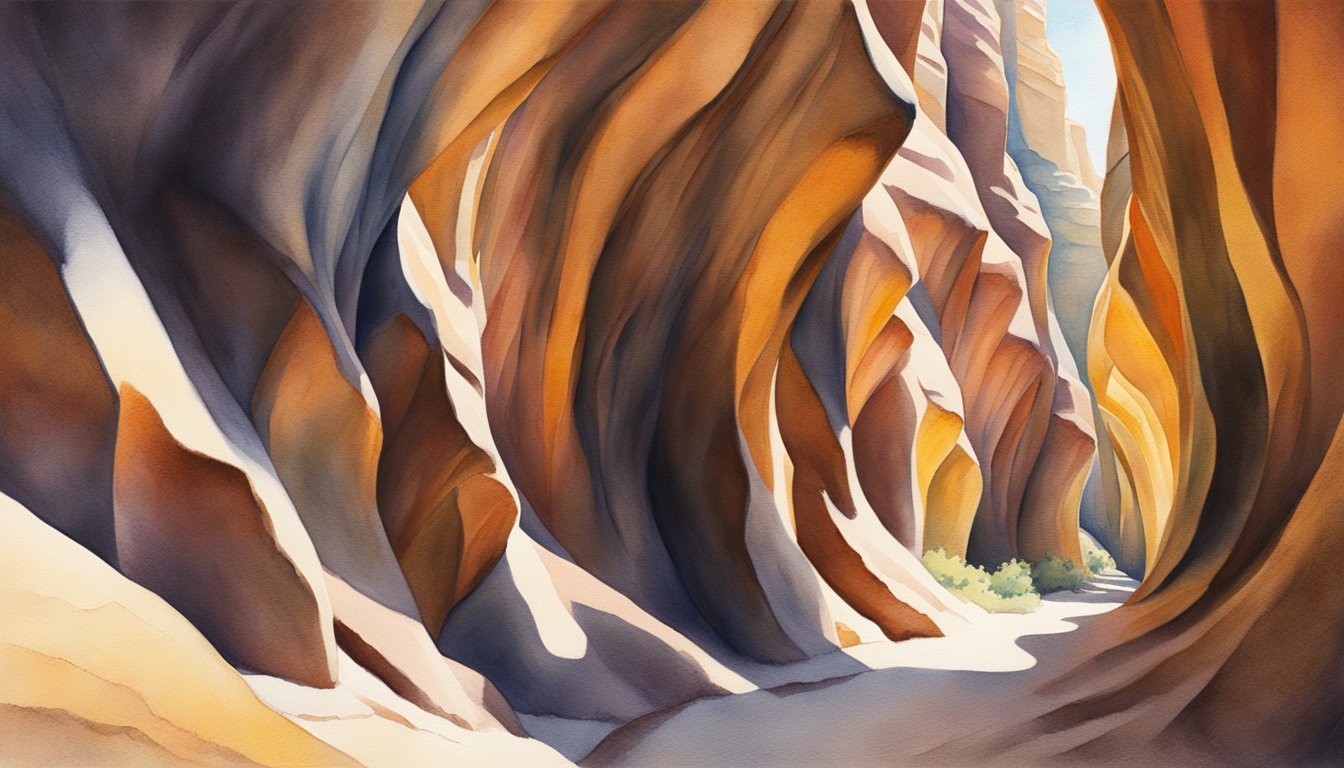Understanding Slot Canyons
Slot canyons offer a starkly beautiful landscape, sculpted by the forces of nature, and are notable for their narrow, winding corridors between towering rock walls. This section delves into the unique features and formations of slot canyons, highlights some renowned examples, and discusses important considerations regarding weather and safety.
Formation and Geography
Slot canyons are intricately carved by the relentless force of water eroding softer rock layers, often sandstone, over millennia. These canyons are characterized by their deep, narrow passageways, where the depth can be significantly greater than the width. The Colorado Plateau, spanning Utah, Arizona, and parts of Nevada and Colorado, is home to numerous slot canyons created by this process. Factors such as the type of rock, regional rainfall, and the specific characteristics of the local drainage systems all contribute to the formation’s distinct features.
Notable Locations
The American Southwest is famed for its concentration of slot canyons. Among them, Zion National Park and the San Rafael Swell in Utah, as well as Antelope Canyon in Arizona, stand out as premier destinations for enthusiasts. The Grand Canyon National Park also hosts a variety of slot canyons, each offering unique photographic and hiking opportunities. Additionally, the Anza-Borrego Desert State Park in California allows visitors to explore its geographic marvels.
Weather and Safety
Navigating slot canyons requires vigilance, particularly concerning weather conditions. Slot canyons are prone to sudden and dangerous flash floods, and even distant rainfall can trigger a surge within these narrow confines. It’s essential for visitors to check weather forecasts and understand the local climate patterns before embarking on an excursion into these natural formations. Proper preparation and respecting the power of nature are critical for a safe slot canyon experience.
Exploring Slot Canyons

Slot canyons offer a unique and thrilling hiking experience characterized by their deep, narrow passageways. These canyons, often carved by water over millions of years, present a striking and scenic environment for adventurers. From potential obstacles such as rappelling and creek crossings to the varying difficulties of hikes, exploring slot canyons requires both keen preparation and respect for nature.
Preparation and Gear
Before setting foot in a slot canyon, it’s crucial to have the right gear and knowledge. Essential items include sturdy hiking shoes for traction within the narrow corridors and a reliable GPS for navigation, as trails may not always be well-marked. Always check the weather conditions to avoid the dangers of flash flooding, a common hazard in slot canyons. For longer treks, such as the longest slot canyon hike in Buckskin Gulch, bring ample water, snacks, and potentially camping gear for overnight stays. Pack out what you pack in, adhering to Leave No Trace principles to preserve the beauty of these natural formations.
Best Hikes for Adventure Seekers
For those craving adventure, the American Southwest is replete with stunning slot canyons, each offering unique challenges and rewards. Peek-a-Boo and Spooky Gulch are a popular loop that provides an experience involving rock scrambling and narrow squeezes. Adventurous hikers might opt for the out-and-back hike in Little Wild Horse Canyon, which requires no technical skills but delivers high on the adventure quotient. Willis Creek, part of the Grand Staircase-Escalante area, offers a scenic hike that is relatively easy and great for beginners.
Responsible Slot Canyon Hiking
Hiking responsibly in slot canyons means understanding the challenges and risks involved. It’s important to plan for the difficulty and length of the hike, which can range from a few hours to multiple days. Be mindful of the ecosystem by avoiding disturbances to the canyon walls or natural obstacles. The risk of flash flooding can escalate quickly, so consulting forecasts and having an evacuation plan is critical. Always inform someone of your plans, especially when venturing into less traveled canyons like those found off the beaten path near Goblin Valley or Escalante River.

